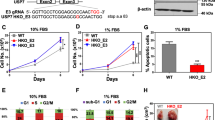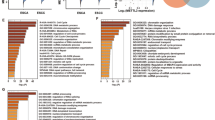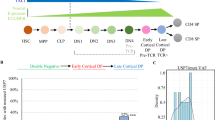Abstract
Mammalian Ste-20-like Kinases 1 and 2 (MST1/2) are core serine-threonine kinases of the Hippo pathway regulating several cellular processes, including cell cycle arrest and cell death. Here, we discovered a novel alternative splicing variant of the MST2 encoding gene, STK3, in malignant cells and tumor datasets. This variant, named STK3∆7 or MST2∆7 (for mRNA or protein, respectively), resulted from the skipping of exon 7. MST2∆7 exhibited increased ubiquitylation and interaction with the E3 ubiquitin-protein ligase CHIP compared to the full-length protein (MST2FL). Exon 7 in STK3 encodes a segment within the kinase domain, and its exclusion compromised MST2 interaction with and phosphorylation of MOB, a major MST1/2 substrate. Nevertheless, MST2∆7 was capable of interacting with MST1 and MST2FL. Unlike MST2FL, overexpression of MST2∆7 did not lead to increased cell death and growth arrest. Strikingly, we observed the exclusion of STK3 exon 7 in 3.2–15% of tumor samples from patients of several types of cancer, while STK3∆7 was seldomly found in healthy tissues. Our study identified a novel STK3 splicing variant with loss of function and the potential to disturb tissue homeostasis by impacting on MST2 activities in the regulation of cell death and quiescence.
This is a preview of subscription content, access via your institution
Access options
Subscribe to this journal
Receive 50 print issues and online access
$259.00 per year
only $5.18 per issue
Buy this article
- Purchase on SpringerLink
- Instant access to full article PDF
Prices may be subject to local taxes which are calculated during checkout





Similar content being viewed by others
Data availability
All data related to this study are available in the main figures and supplementary material.
Code availability
Code used for image quantification can be found at https://github.com/brunicardoso/e-signal-lab. Code used for bioinformatics analysis can be made available upon request.
References
Gokhale R, Pfleger CM. The power of drosophila genetics: the discovery of the hippo pathway. Methods Mol Biol. 2019;1893:3–26.
Kodaka M, Hata Y. The mammalian Hippo pathway: regulation and function of YAP1 and TAZ. Cell Mol Life Sci. 2015;72:285–306.
Ding R, Weynans K, Bossing T, Barros CS, Berger C. The Hippo signalling pathway maintains quiescence in Drosophila neural stem cells. Nat Commun. 2016;7:10510.
Wang D, He J, Huang B, Liu S, Zhu H, Xu T. Emerging role of the Hippo pathway in autophagy. Cell Death Dis. 2020;11:880.
Saucedo LJ, Edgar BA. Filling out the Hippo pathway. Nat Rev Mol Cell Biol. 2007;8:613–21.
Ni L, Zheng Y, Hara M, Pan D, Luo X. Structural basis for Mob1-dependent activation of the core Mst–Lats kinase cascade in Hippo signaling. Genes Dev. 2015;29:1416–31.
Harvey KF, Zhang X, Thomas DM. The Hippo pathway and human cancer. Nat Rev Cancer. 2013;13:246–57.
Liu CY, Zha ZY, Zhou X, Zhang H, Huang W, Zhao D, et al. The hippo tumor pathway promotes TAZ degradation by phosphorylating a phosphodegron and recruiting the SCFβ-TrCP E3 ligase. J Biol Chem. 2010;285:37159–69.
Cui J, Zhou Z, Yang H, Jiao F, Li N, Gao Y, et al. MST1 suppresses pancreatic cancer progression via ROS-induced pyroptosis. Mol Cancer Res. 2019;17:1316–25.
Liu X-F, Han Q, Yang M, Lin X-Y, Han Y-C, et al. Article MST1 inhibits cell proliferation and invasion of non-small-cell lung cancer by regulating YAP phosphorylation and Hippo pathway. Int J Clin Exp Pathol. 2018;11:2613–20.
Zhou D, Conrad C, Xia F, Park JS, Payer B, Yin Y, et al. Mst1 and Mst2 maintain hepatocyte quiescence and suppress hepatocellular carcinoma development through inactivation of the Yap1 oncogene. Cancer Cell. 2009;16:425–38.
Zhou D, Zhang Y, Wu H, Barryg E, Yin Y, Lawrence E, et al. Mst1 and Mst2 protein kinases restrain intestinal stem cell proliferation and colonic tumorigenesis by inhibition of Yes-associated protein (Yap) overabundance. Proc Natl Acad Sci USA 2011;108:1312–20.
Zhang H, Qu X, Han L, Di X. Mst2 overexpression inhibits thyroid carcinoma growth and metastasis by disrupting mitochondrial fitness and endoplasmic reticulum homeostasis. J Oncol. 2021;6:1262291.
Harvey KF, Pfleger CM, Hariharan IK. The Drosophila Mst ortholog, hippo, restricts growth and cell proliferation and promotes apoptosis. Cell. 2003;114:457–67.
Lange AW, Sridharan A, Xu Y, Stripp BR, Perl AK, Whitsett JA. Hippo/Yap signaling controls epithelial progenitor cell proliferation and differentiation in the embryonic and adult lung. J Mol Cell Biol. 2015;7:35–47.
Wu S, Huang J, Dong J, Pan D. Hippo encodes a Ste-20 family protein kinase that restricts cell proliferation and promotes apoptosis in conjunction with Salvador and warts. Cell. 2003;114:445–56.
Matsumoto H, Murakami Y, Kataoka K, Lin H, Connor KM, Miller JW et al. Mammalian STE20-like kinase 2, not kinase 1, mediates photoreceptor cell death during retinal detachment. Cell Death Dis. 2014. https://doi.org/10.1038/cddis.2014.218.
Fu M, Hu Y, Lan T, Guan KL, Luo T, Luo M. The Hippo signalling pathway and its implications in human health and diseases. Signal Transduct Target Ther. 2022. https://doi.org/10.1038/s41392-022-01191-9.
Rizki A, Weaver VM, Lee SY, Rozenberg GI, Chin K, Myers CA, et al. A human breast cell model of preinvasive to invasive transition. Cancer Res. 2008;68:1378–87.
Fiore APZP, Rodrigues AM, Ribeiro-Filho HV, Manucci AC, de Freitas Ribeiro P, Botelho MCS, et al. Extracellular matrix stiffness regulates degradation of MST2 via SCF βTrCP. Biochim Biophys Acta Gen Subj. 2022;1866:130238.
Praskova M, Khoklatchev A, Ortiz-Vega S, Avruch J. Regulation of the MST1 kinase by autophosphorylation, by the growth inhibitory proteins, RASSF1 and NORE1, and by Ras. Biochem J. 2004;381:453–62.
Praskova M, Xia F, Avruch J. MOBKL1A/MOBKL1B phosphorylation by MST1 and MST2 inhibits cell proliferation. Curr Biol. 2008;18:311–21.
Lee KK, Ohyama T, Yajima N, Tsubuki S, Yonehara S. MST, a physiological caspase substrate, highly sensitizes apoptosis both upstream and downstream of caspase activation. J Biol Chem. 2001;276:19276–85.
Graves JD, Gotoh Y, Draves KE, Ambrose D, Han DKM, Wright M, et al. Caspase-mediated activation and induction of apoptosis by the mammalian Ste20-like kinase Mst1. EMBO J. 1998;17:2224–34.
Lin Y, Khokhlatchev A, Figeys D, Avruch J. Death-associated protein 4 binds MST1 and augments MST1-induced apoptosis. J Biol Chem. 2002;277:47991–8001.
Song H, Mak KK, Topol L, Yun K, Hu J, Garrett L, et al. Mammalian Mst1 and Mst2 kinases play essential roles in organ size control and tumor suppression. Proc Natl Acad Sci USA 2010;107:1431–6.
Fiore APZP, Ribeiro P, de F, Bruni-Cardoso A. Sleeping beauty and the microenvironment enchantment: microenvironmental regulation of the proliferation-quiescence decision in normal tissues and in cancer development. Front Cell Dev Biol. 2018;6:59.
Fiore APZP, Spencer VA, Mori H, Carvalho HF, Bissell MJ, Bruni-Cardoso A. Laminin-111 and the level of nuclear actin regulate epithelial quiescence via exportin-6. Cell Rep. 2017;19:2102–15.
Debnath J, Muthuswamy SK, Brugge JS. Morphogenesis and oncogenesis of MCF-10A mammary epithelial acini grown in three-dimensional basement membrane cultures. Methods. 2003;30:256–68.
Kirchner P, Bourdenx M, Madrigal-Matute J, Tiano S, Diaz A, Bartholdy BA, et al. Proteome-wide analysis of chaperone-mediated autophagy targeting motifs. PLoS Biol. 2019;17:e3000301.
Makwana KM, Mahalakshmi R. Implications of aromatic-aromatic interactions: From protein structures to peptide models. Protein Sci. 2015;24:1920–33.
Won GW, Park SH, Park J, Lee Y, Lee YH. Mammalian Hippo kinase pathway is downregulated by BCL-2 via protein degradation. Biochem Biophys Res Commun. 2019;512:87–92.
Carafa V, Altucci L. Deregulation of cell death in cancer: recent highlights. Cancers. 2020;12:1–4.
Hanahan D, Weinberg RA. Hallmarks of cancer: the next generation. Cell. 2011;144:646–74.
Dzobo K, Senthebane DA, Dandara C. The tumor microenvironment in tumorigenesis and therapy resistance revisited. Cancers. 2023;15:376.
Gonzalez H, Hagerling C, Werb Z. Roles of the immune system in cancer: from tumor initiation to metastatic progression. Genes Dev. 2018;32:1267–84.
Arshad Z, McDonald JF. Changes in gene-gene interactions associated with cancer onset and progression are largely independent of changes in gene expression. iScience. 2021;24:103522.
Bjørklund SS, Panda A, Kumar S, Seiler M, Robinson D, Gheeya J, et al. Widespread alternative exon usage in clinically distinct subtypes of invasive ductal carcinoma. Sci Rep. 2017;7:5568.
Kahles A, Lehmann KVan, Toussaint NC, Hüser M, Stark SG, Sachsenberg T, et al. Comprehensive analysis of alternative splicing across tumors from 8705 patients. Cancer Cell. 2018;34:211–24.
Paik PK, Drilon A, Fan PD, Yu H, Rekhtman N, Ginsberg MS, et al. Response to MET inhibitors in patients with stage IV lung adenocarcinomas harboring met mutations causing exon 14 skipping. Cancer Discov. 2015;5:842–50.
Rawat C, Heemers HV. Alternative splicing in prostate cancer progression and therapeutic resistance. Oncogene. 2024;43:1655–68.
Liu J, Lichtenberg T, Hoadley KA, Poisson LM, Lazar AJ, Cherniack AD, et al. An integrated TCGA pan-cancer clinical data resource to drive high-quality survival outcome analytics. Cell. 2018;173:400–16.
Kole R, Krainer AR, Altman S. RNA therapeutics: beyond RNA interference and antisense oligonucleotides. Nat Rev Drug Discov. 2012;11:125–40.
Hong D, Kurzrock R, Kim Y, Woessner R, Younes A, Nemunaitis J, et al. AZD9150, a next-generation antisense oligonucleotide inhibitor of STAT3 with early evidence of clinical activity in lymphoma and lung cancer. Sci Transl Med. 2015;7:314ra185.
Chi KN, Yu EY, Jacobs C, Bazov J, Kollmannsberger C, Higano CS, et al. A phase I dose-escalation study of apatorsen (OGX-427), an antisense inhibitor targeting heat shock protein 27 (Hsp27), in patients with castration-resistant prostate cancer and other advanced cancers. Ann Oncol. 2016;27:1116–22.
Skordis LA, Dunckley MG, Yue B, Eperon IC, Muntoni F. Bifunctional antisense oligonucleotides provide a trans-acting splicing enhancer that stimulates SMN2 gene expression in patient fibroblasts. Proc Natl Acad Sci USA 2003;100:4114–9.
Russo LC, Tomasin R, Matos IA, Manucci AC, Sowa ST, Dale K, et al. The SARS-CoV-2 Nsp3 macrodomain reverses PARP9/DTX3L-dependent ADP-ribosylation induced by interferon signaling. J Biol Chem. 2021;297:101041.
Dobin A, Davis CA, Schlesinger F, Drenkow J, Zaleski C, Jha S, et al. STAR: ultrafast universal RNA-seq aligner. Bioinformatics. 2013;29:15–21.
Acknowledgements
The authors are grateful to Antonio Manucci, Beatriz Moraes, Eduardo Moraes Rego Reis, and Nicolas Hoch for scientific discussions, advice on experiments and insightful inputs. The authors also wish to thank Celia Ludio for technical assistance.
Funding
This work was supported by Fundação de Amparo à Pesquisa do Estado de São Paulo (FAPESP #2014/10492–0 and #2019/26767–2). RT was initially funded by Instituto Serrapilheira and subsequently by a CAPES postdoctoral fellowship (88882.315500/2019–01). APZPF was a recipient of FAPESP postdoctoral fellowship (#2014/25832–1). AMR was supported by a PhD scholarship from CAPES (88882.332986/2019–01).
Author information
Authors and Affiliations
Contributions
AMR, APZPF, and AB-C conceptualized the work; AMR. APZPF, DS, RT, RJG, AB-C, and MP designed the experiments; PAFG and GADG designed and performed bioinformatics analysis. AMR, APZPF, RT, and AAT performed experiments; AMR, AB-C, and APZPF were responsible for data curation; AB-C and AMR wrote the manuscript; AB-C supervised the work; AB-C, MP, and DS acquired funding to support this work.
Corresponding author
Ethics declarations
Competing interests
The authors declare no competing interests.
Ethics approval and consent to participate
Our research involved human material and human data used in accordance with the Declaration of Helsinki. The RNA samples utilized in the analysis presented in Fig. 5F were extracted from patient samples stored in the Biobank of the São Paulo Cancer Institute Octavio Frias de Oliveira (ICESP). Informed consent was obtained from all subjects. To use these samples, we obtained approval from the National Ethics Committee in Brazil (Comissão Nacional de Ética em Pesquisa; CAAE: 06373719.0.3001.0065).
Additional information
Publisher’s note Springer Nature remains neutral with regard to jurisdictional claims in published maps and institutional affiliations.
Supplementary information
Rights and permissions
Springer Nature or its licensor (e.g. a society or other partner) holds exclusive rights to this article under a publishing agreement with the author(s) or other rightsholder(s); author self-archiving of the accepted manuscript version of this article is solely governed by the terms of such publishing agreement and applicable law.
About this article
Cite this article
Rodrigues, A.M., Paula Zen Petisco Fiore, A., Guardia, G.D.A. et al. Identification of a novel alternative splicing isoform of the Hippo kinase STK3/MST2 with impaired kinase and cell growth suppressing activities. Oncogene 43, 2938–2950 (2024). https://doi.org/10.1038/s41388-024-03104-2
Received:
Revised:
Accepted:
Published:
Issue date:
DOI: https://doi.org/10.1038/s41388-024-03104-2



